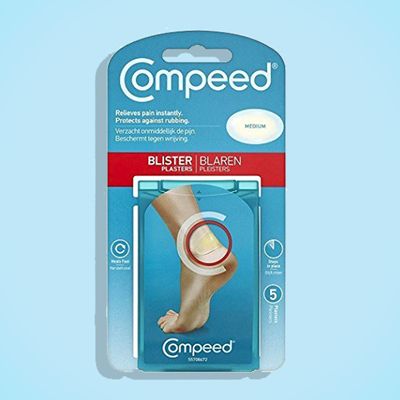
I discovered Compeed bandages in Paris on my honeymoon. Between dancing all night in my crazy-tall shoes and then walking ten-plus miles a day around Paris, I had disgusting, blistery Achilles tendons (chic!), and was prepared to give up a day at the museum in favor of drinking Côtes du Rhône at a café. But right outside the Musée d’Orsay, I stepped into a pharmacy and discovered a blue, Listerine Strip–style package of gloriously cushioned, medicated bandages. Unlike Band-Aids, they were big enough to cover my heels and had just enough padding that, even when I put my shoes back on, the stinging pain was gone. Plus, the translucent nude material formed to my foot, so it was practically invisible and didn’t scream “American Tourist With Impractical Choice of Footwear” over the back of my flats.
Just like the package promised, the bandages stayed on all week, even in the shower, and only came off when the blisters underneath were completely healed. They start to turn white directly atop the wound as the healing process begins — hydrocolloid technology in action, according to Compeed’s website — which adds a kind of gross satisfaction that it’s working. (They’re like the pimple patches of the blister world.)
I brought four more boxes home with me, and used them at the first signs of friction from a new pair of heels or running shoes. And when that batch ran out, I went to CVS and bought what I thought was a similar (American) product. Nope — far from it. I sweat those right off during a run. Only the original Compeed brand will do, and now I get them on Amazon. I’ll order several packs at a time (now I wear them preventively), and I haven’t gotten a blister since. Bring on the impractical footwear.
More Strat-approved foot savers
We spoke to a doctor about how to prevent blisters, and Dr. Lori Weisenfeld, a New York City sports podiatrist, recommended using these on any spot that experiences friction. “Preventing a blister is all about preventing that friction from happening in the first place,” says Weisenfeld, who notes that blisters are most prevalent at the start of sandal season.
Shoes too small? Writer Caroline Bankoff found a solution in this leather-stretching shoe spray, which she used on shoes that hurt her feet: “The instructions on the bottle said to ‘spray heavily,’ so I completely soaked the interior of the shoes. Then I put them on and clunked around outside for 15 minutes or so, pausing periodically to flex my feet as much as possible (two people stopped to ask if I was all right). After letting the shoes dry out, I repeated the process. When I put them on later that day, they fit perfectly.
If you’re trying to smooth rough feet, beauty writer Hannah Morrill recommends a cream she learned about from dermatologists: “I’ll rub it all over my feet and be someone who sleeps with socks on for just one night. In the morning, the fine white fissures in my toes and along the heels will have disappeared, craggy cuticles will have laid flat, and the ashy nubs around big toes will have receded. The cream also contains glycerin, ceramides, hyaluronic acid, and cholesterol — a.k.a., the very best skin moisturizers science knows about right now.”
The Strategist is designed to surface the most useful, expert recommendations for things to buy across the vast e-commerce landscape. Some of our latest conquests include the best acne treatments, rolling luggage, pillows for side sleepers, natural anxiety remedies, and bath towels. We update links when possible, but note that deals can expire and all prices are subject to change.









